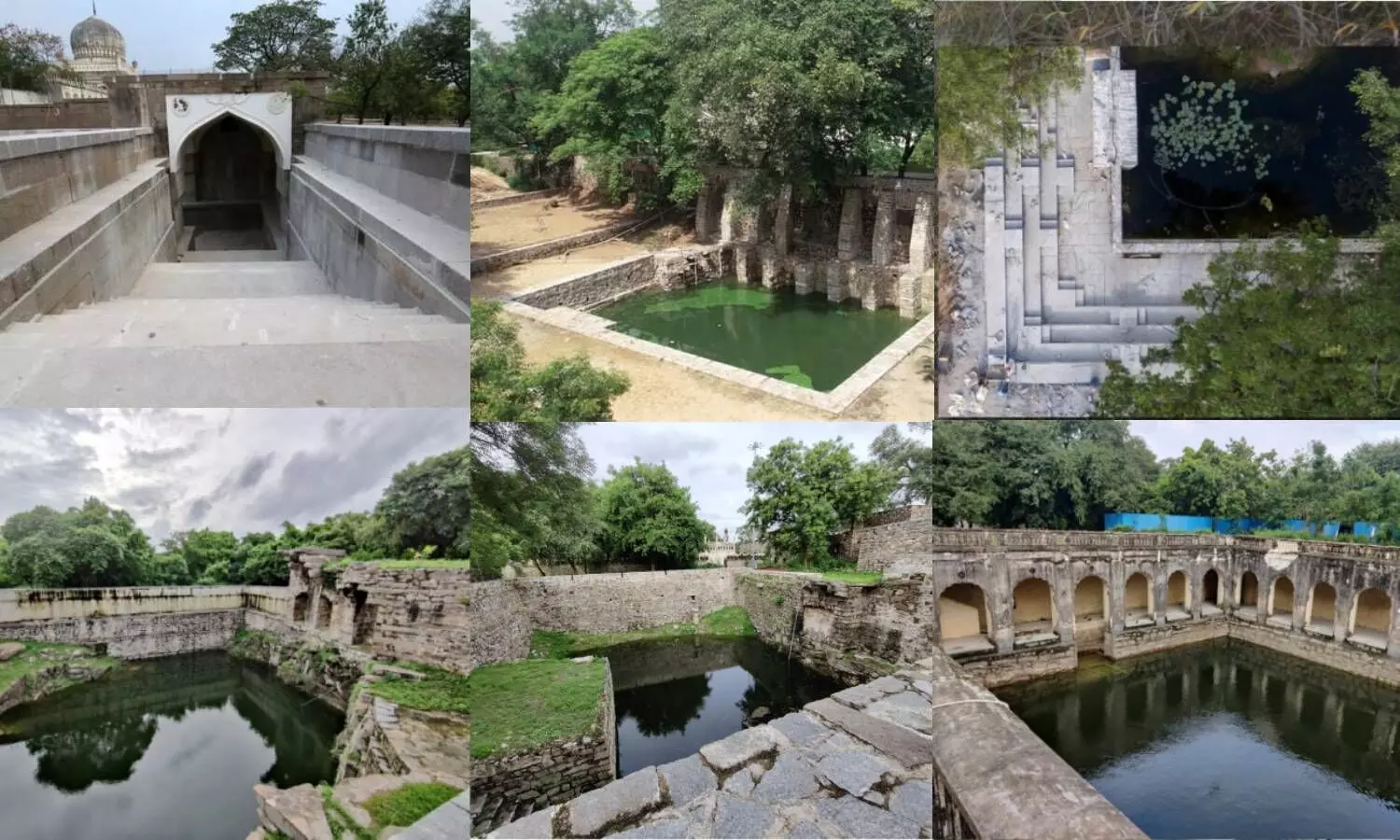Restoring history: Dilapidated baolis of Qutub Shahi Heritage Park reclaim their lost beauty
Nestled between the many tombs of Qutub Shahi Heritage Park in Hyderabad are the six baolis brimming with water. All six – Badi, Bagh, Eastern, Idgah, Western and Hamam baolis – are almost at total capacity. Altogether, the baolis have a capacity of 19.3 million liters.
By Amrutha Kosuru
Hyderabad: Nestled between the many tombs of Qutub Shahi Heritage Park in Hyderabad are the six baolis brimming with water. All six – Badi, Bagh, Eastern, Idgah, Western and Hamam baolis – are almost at total capacity. Altogether, the baolis have a capacity of 19.3 million liters.
Badi Baoli
The Badi Baoli was the first one to be restored. The well was found in a dilapidated state by the Aga Khan Trust for Culture (AKTC).
"The western face of the Badi Baoli collapsed during 2012-13, requiring the structure to be closed to the public while major repairs were carried out by the project team," explained Aditi Deshpande, Conservation architect at AKTC.
Badi Baoli Before Restoration
Badi Baoli After Restoration
AKTC reinstated the west side access from the ground level to the lower arcaded terrace of the baoli. Out of 17 steps, 10 along the western wall had collapsed. These granite steps were reinstated. Aditi recalled that it took over 4,000 man-days for AKTC to remove the debris.
The Badi Baoli has a capacity of 3.5 million liters. It also houses aquatic life, including a few turtles.
AKTC is in charge of the conservation work at Qutub Shahi Heritage Park.
Bagh Baoli
The Bagh Baoli is located along the eastern edge of the site, on the route to Golconda. It was also found with its walls mostly collapsed. It is now known to be 12m deep, measuring 12.6 x 18.60 m, and is devoid of any surviving evidence of architectural ornamentation.
Bagh Baoli Before Restoration
Bagh Baoli After Restoration
"The reservoir has a projected platform that was mostly collapsed along the northern wall built in coursed ashlar masonry," Aditi explained.
AKTC began the restoration work for the Bagh Baoli in 2021. A charbagh (it is a Persian and Indo-Persian quadrilateral garden layout based on the four gardens of Paradise mentioned in the Quran) has been developed at the Bagh Baoli as a landscape feature inspired by the archaeological area at the heritage park. The proposed landscaping provides seating space for visitors along with a venue for cultural events.
Eastern Baoli
The Eastern Baoli was found in deep earthen mold and mud. "The stepwell was almost unseen due to the deep vegetation growth," Aditi said and added that it was difficult to understand how the stepwell was earlier restored.
Eastern Baoli Before Restoration
Eastern Baoli After Restoation
"Thorough architectural documentation of the stepwell was completed to understand the original profile of buttresses. Hence, restoration of the dilapidated buttresses on the western wall was carried out matching the historic masonry," she said.
The Eastern Baoli has a capacity of 3.5 million liters. Originally a stepwell, the Eastern Baoli is now filled with so much water that the steps are barely visible.
Idgah Baoli
The Idgah Baoli is perhaps the grandest stepwell of all at Qutub Shahi Heritage Park.
The baoli is built with hand-dressed granite stones with archway access on the south side. The facades on the archway are decorated with intricate lime stucco.
Idgah Baoli Before Restoration
"Over 120 large-sized granite stone blocks were cut to size and hand dressed by a team of stone craftsmen and installed in the missing portions on the south and south-east portions of the baoli," Aditi said.
Further, missing portions of the east, southeast, and south side retaining walls of the Idgah Baoli were reconstructed using large-sized granite stone blocks matching the in-situ evidence.
Idgah Baoli After Restoration
The Idgah Baoli is also home to aquatic life and is frequently visited by birds as well.
Western Baoli
On a serene evening, the Western Baoli is the place to be.
It is located to the west of Jamshed Quli Qutb Shah's mausoleum and stands on the western edge of the Qutb Shahi Heritage Park. It is quiet and peaceful, nestled between big trees on one side.
Western Baoli Before Restoration
Western Baoli After Restoration
"This was the main distributary well amongst the network of stepwells found within the complex. The discovery of the aqueducts during excavations has shown that it received water from Durgam Cheruvu lake, located several miles north of here. This aqueduct was also the principal water supply line to the Golconda fort, standing south of the necropolis," Aditi explained.
She added, "The structure was in a state of serious deterioration with the walls crumbling, most of the steps missing and the baoli being used to dump construction waste."
The aqueduct feeding the Western Baoli was excavated, cleaned, and made functional by AKTC. Damaged portions of the parapet walls were restored by skilled stone masons using site evidence.
Hamam Baoli
The Hamam Baoli is a hidden gem. It's set behind the Hamam (Iranian Bathhouse) at the Qutub Shahi Heritage Park.
The exquisite Hamam was provided with its own stepwell to fulfill the water requirements of the elaborate mechanisms for the baths. "The retaining walls at this baoli are built using local granite stone in random rubble stone masonry with a series of stone steps leading down at the western side," Aditi explained.
Hamam Baoli Before Restoration
Hamam Baoli After Restoration
Before conservation, the baoli was filled with construction rubble, the retaining walls were overgrown with vegetation, and several portions had collapsed.
AKTC found that the connected aqueducts provide water to the hamam baoli which is used to irrigate and maintain the green spaces at the forecourt of Mohammad Quli Qutb Shah's mausoleum.
The six significant baolis at Qutb Shahi Heritage Park were conserved by Aga Khan Trust for Culture in partnership with the Department of Heritage Telangana, with the support of the US Ambassadors Fund for Cultural Preservation and TATA Trusts .